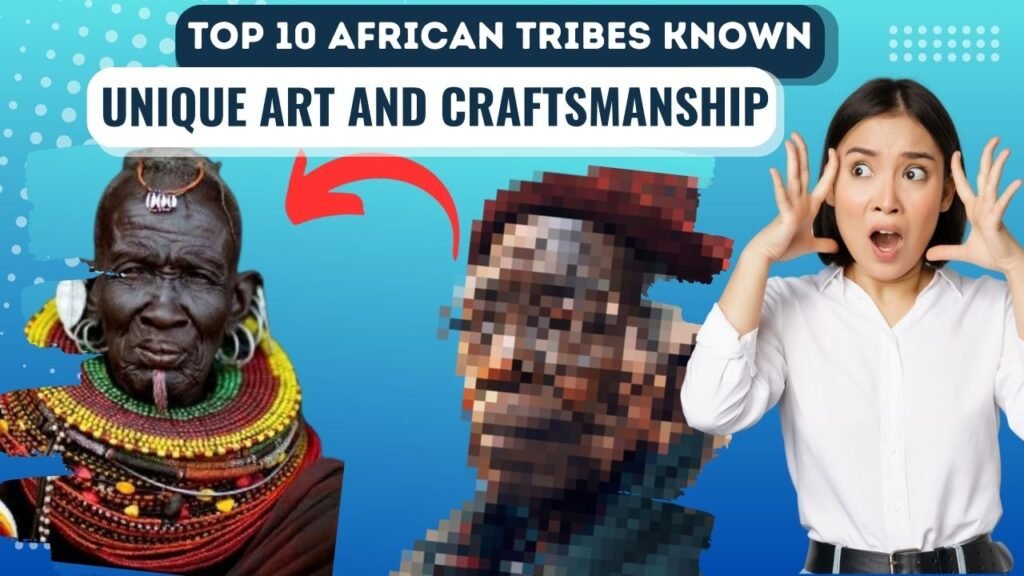
Introduction
Africa is a continent with a lot of different cultures, history, and art. It has a lot of different African tribes, but some stand out for the amazing art and craftsmanship they have made. These tribes have passed down their traditional skills from generation to generation, making works that are unique, amazing, and known all over the world.
African Tribes
The top 10 African tribes known for their unique art and craftsmanship are looked at in this article. It talks about their history, styles, techniques, and cultural importance.
You may also like: 14 Most Fearless African Tribes: Exploring Courage and Resilience
Yoruba Tribe
Historical Development
The history of the Yoruba people, who live mostly in Nigeria, goes back to the 7th century and is very interesting. Their religion and culture are deeply rooted in their art, which helps them connect with their ancestors and gods.
Themes and Styles
The intricate patterns and symbolic meanings in Yoruba art are what make it unique. Themes that are often used are gods, royalty, and people, who are often shown with exaggerated features to emphasize their spiritual importance.
Techniques Used
Yoruba artists are very good at carving wood, making beads, and working with metal. To make masks, sculptures, and objects used in ceremonies, they use traditional tools and methods that have been passed down from generation to generation.
Notable Works
The Ife bronzes, which are known for being realistic and high-class, and the elaborate beaded crowns that Yoruba kings wore are two important pieces. Not only are these works of art, but they also have important religious and cultural meanings.
Cultural Impact
A lot of African art has been influenced by Yoruba art. Pieces of it can be seen in museums all over the world because of how spiritually deep and aesthetically beautiful they are. African artists today are still influenced by the Yoruba people’s art traditions.
Contemporary Scene
At this point, Yoruba artists use both old and new styles to make art that shows both their rich history and modern life. Festivals and other cultural events help keep these traditions alive so that they can be passed down to future generations.
Maasai Tribe

Historical Development
The Maasai people live mostly in Kenya and Tanzania. They are known for having a lively culture. Their art and craftsmanship are a big part of who they are, and they show how connected they are to nature and the nomad life they live.
Themes and Styles
Maasai art is bright and colorful, with patterns and motifs that come from their daily lives and the world around them. Animals, warriors, and rural scenes are common themes that are often shown in bright, geometric patterns.
Techniques Used
Maasai craftspeople are good at working with metal, beads, and leather. They make intricate jewelry, clothes, and ceremonial items from materials found in their own communities. Often, they work together to make these things.
Notable Works
Necklaces, bracelets, and headpieces with beads are popular Maasai accessories that are worn during important ceremonies and rites of passage. These things aren’t just for looks; they also show who you are and your social status in the tribe.
Cultural Impact
The unique style and bright colors of Maasai art have made it famous around the world. It has become a symbol of African culture, and pieces of it are often shown in fashion collections and exhibitions around the world.
Contemporary Scene
Modern Maasai artists keep coming up with new ideas by adding modern styles to traditional crafts. Their work helps their communities’ economies grow and preserves culture while also promoting sustainability.
Zulu Tribe
Historical Development
The Zulu people, who are the largest group of people in South Africa, have a long history of making art and crafts. Zulu art is deeply connected to their cultural practices, such as ceremonies for important people and ways of life for warriors.
Themes and Styles
There are big patterns, bright colors, and symbolic motifs in Zulu art. Themes usually include everyday life, war, and spirituality, with a big focus on group identity and telling stories from the past.
Techniques Used
Zulu artists are very good at making pottery, weaving, and beadwork. Using techniques that have been improved over hundreds of years, they make useful and pretty things out of natural materials like grass, clay, and beads.
Notable Works
Jewelry with many small beads, woven baskets, and ceremonial shields are some of the most famous Zulu works. These things are important parts of different cultures’ rituals and show who you are and your heritage.
Cultural Impact
Zulu art is an important part of keeping the tribe’s history and traditions alive. Pieces of it are shown in museums and other cultural centers all over the world because of how well they are made and how important they are to culture.
Contemporary Scene
Zulu artists today are incorporating modern styles while still using old-fashioned methods. Their work is shown in art galleries, fashion shows, and cultural festivals, which shows how changing Zulu art is.
Ndebele Tribe

Historical Development
The Ndebele tribe, which lives mostly in South Africa and Zimbabwe, is known for making art with lots of colors and shapes. Their artistic traditions are a lively way to show who they are as a culture and how they live together as a society.
Themes and Styles
Bright colors and strong geometric shapes are typical of Ndebele art. Most of the time, everyday life, community, and nature are the themes, and each pattern and color has its own meaning.
Techniques Used
The Ndebele are known for their painting, weaving, and beadwork skills. They use natural dyes and beads to make murals, jewelry, and textiles with a lot of detail. Often, they work together to make big pieces.
Notable Works
The intricately painted houses and the beaded clothing worn during ceremonies are two of the most famous Ndebele works. Not only are these works of art, but they also carry important cultural messages and traditions.
Cultural Impact
People really like Ndebele art because it is both beautiful and culturally important. It has been shown in many international shows, and its unique style has affected art and design trends around the world.
Contemporary Scene
Ndebele artists today are still coming up with new ideas by mixing traditional patterns with modern ones. Their work encourages cultural tourism and economic growth in their communities, which helps to keep cultures alive.
You may also like: 10 Famous People Who Converted to Islam: Exploring Conversion Stories
Tuareg Tribe
Historical Development
The “Blue People” of the Sahara are the Tuareg tribe, who have a long history of making art and crafts. Their art shows how they lived as nomads and how connected they were to the desert.
Themes and Styles
The environment and culture of the Tuareg people have influenced their art, which has complex patterns and symbols. Nature, spirituality, and everyday life are common themes that are often shown in abstract and geometric shapes.
Techniques Used
The Tuareg are very good at working with metal, leather, and making jewelry. They use old-fashioned tools and methods to make intricate silver jewelry, leather goods, and home decor items, which often have religious or symbolic designs on them.
Notable Works
Silver jewelry, leather bags, and swords with designs carved into them are all Tuareg signature items. These things are useful, but they are also important cultural symbols that show who the tribe is and what their heritage is.
Cultural Impact
The unique style and quality of Tuareg art have made it famous around the world. Pieces of it can be seen in museums and galleries all over the world because of their cultural importance and beauty.
Contemporary Scene
Tuareg artists today are always coming up with new ideas by combining old techniques with new designs. Their work helps their communities keep their cultures alive and grow economically, which is good for sustainability.
Ashanti Tribe

Historical Development
Ghana is home to the Ashanti tribe, which is known for its rich cultural history and artistic traditions. The social and political systems of the Ashanti people are deeply rooted in their art, which shows their history and beliefs.
Themes and Styles
Ashanti art has complex patterns and themes that represent important ideas. Royalty, mythology, and everyday life are all common themes that are often shown in very detailed and decorative ways.
Techniques Used
Ashanti craftspeople are good at making jewelry out of gold, carving wood, and weaving fabrics. They make jewelry, sculptures, and kente cloth, which is known for its bright colors and patterns, using old tools and methods.
Notable Works
Gold jewelry, wooden stools, and kente cloth are all important Ashanti items. People really value these things because they are well-made and have cultural meaning. They are often used in ceremonies and as status symbols.
Cultural Impact
Art from Ashanti has had a big impact on art from West Africa as a whole. Pieces of it are shown in museums and other cultural centers all over the world because of how beautiful they are and how much they teach us about other cultures.
Contemporary Scene
Today, Ashanti artists are still coming up with new ideas and bringing modern ideas into traditional crafts. Their work helps keep cultures alive and the economy growing, which makes their communities more stable.
Dogon Tribe
Historical Development
The Dogon people live in Mali and are famous for their unique art and crafts. Dogon art has a lot to do with their religion and spiritual beliefs, which shows how complicated their social and religious systems are.
Themes and Styles
Dogon art has complex patterns and meanings that are represented by symbols. Mythology, ancestors, and the natural world are common themes that are often shown in geometric and abstract ways.
Techniques Used
The Dogon are very good at carving wood, working with metal, and making pottery. They use traditional tools and methods to make masks, sculptures, and objects used in ceremonies. Often, they work together with other people in their communities.
Notable Works
Masks made of wood, sculptures made of bronze, and granary doors are all famous Dogon art. These things are not only works of art, but they are also important cultural symbols that show who the tribe is and what their heritage is.
Cultural Impact
Dogon art is known all over the world for its unique style and high level of craftsmanship. Pieces of it can be seen in museums and galleries all over the world because of their cultural importance and beauty.
Contemporary Scene
Dogon artists today are always coming up with new ideas by combining old techniques with new designs. Their work helps their communities keep their cultures alive and grow economically, which is good for sustainability.
Samburu Tribe
Historical Development
The Samburu people live mostly in Kenya. They are known for having a lively culture. Their art and craftsmanship are a big part of who they are, and they show how connected they are to nature and the nomad life they live.
Themes and Styles
Samburu art is bright and colorful, with patterns and themes that come from their daily lives and the world around them. Animals, warriors, and rural scenes are common themes that are often shown in bright, geometric patterns.
Techniques Used
Samburu craftspeople are good at working with metal, beads, and leather. They make intricate jewelry, clothes, and ceremonial items from materials found in their own communities. Often, they work together to make these things.
Notable Works
Necklaces, bracelets, and headpieces with beads are typical Samburu jewelry. These are worn during important ceremonies and rites of passage. These things aren’t just for looks; they also show who you are and your social status in the tribe.
Cultural Impact
The unique style and bright colors of Samburu art have made it famous around the world. It has become a symbol of African culture, and pieces of it are often shown in fashion collections and exhibitions around the world.
Contemporary Scene
Modern Samburu artists keep coming up with new ideas by adding modern designs to traditional crafts. Their work helps their communities’ economies grow and preserves culture while also promoting sustainability.
Himba Tribe
Historical Development
The Himba people, who live mostly in Namibia, are known for their unique art and craftsmanship. Himba art shows how they lived a semi-nomadic life and how deeply they connected with their ancestors and the land.
Themes and Styles
Himba art is known for using natural materials and designs that mean something. Nature, spirituality, and everyday life are common themes that are often shown in earthy colors and organic shapes.
Techniques Used
The Himba are very good at making pottery, leather goods, and beaded items. They use traditional tools and techniques to make jewelry, clothes, and objects used in ceremonies. Often, they work together with other people in their communities.
Notable Works
Beaded necklaces, leather skirts, and hairstyles covered in clay are all Himba signature items. These things are not only works of art, but they are also important cultural symbols that show who the tribe is and what their heritage is.
Cultural Impact
The unique style and quality of Himba art have made it famous around the world. Pieces of it can be seen in museums and galleries all over the world because of their cultural importance and beauty.
Contemporary Scene
Himba artists today are always coming up with new ideas by combining old techniques with new designs. Their work helps their communities keep their cultures alive and grow economically, which is good for sustainability.
Berber Tribe
Historical Development
The Berber people are from North Africa and have a long history of making art and crafts. Berber art shows how deeply they are connected to their land and traditions and how many different cultures they come from.
Themes and Styles
Berber art has complex patterns and motifs that stand for things. Nature, spirituality, and everyday life are common themes that are often shown in abstract and geometric shapes.
Techniques Used
Berber artists are very good at making pottery, weaving, and metalwork. They make intricate carpets, jewelry, and ceramics using traditional tools and methods. Often, they work together with other people in their communities.
Notable Works
Weaved carpets, silver jewelry, and pottery are all famous Berber items. These things are not only works of art, but they are also important cultural symbols that show who the tribe is and what their heritage is.
Cultural Impact
The unique style and quality of Berber art have made it famous around the world. Pieces of it can be seen in museums and galleries all over the world because of their cultural importance and beauty.
Contemporary Scene
Modern Berber artists keep coming up with new ideas by mixing old techniques with new designs. Their work helps their communities keep their cultures alive and grow economically, which is good for sustainability.
Conclusion
Summary of Key Points
The art and crafts of these 10 top African tribes show how culturally and artistically diverse Africa is. Each tribe has its own style, themes, and techniques that come from its history, beliefs, and way of life. From the Maasai’s intricate beadwork to the Ndebele’s patterns that stand for things, these art forms show us what Africa is really like.
Call to Action for Further Education
We encourage you to learn more about African art, go to exhibitions, and support local artists if you want to really understand how deep and beautiful it is. In this way, you help protect these important cultural traditions for future generations.



